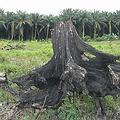2月初兩份最新研究報告紛紛指出:為生質燃料清出大片農地來種植穀物,對緩和全球暖化趨勢恐怕會會適得其反。這兩組研究不約而同針對目前將自然生態圈改為農地的現象提出警訊,認為此舉會釋出大量二氧化碳,而使用生質燃料並非如預期有效避免石化燃料所造成的環境傷害。
 為了生產生質燃料而大規模種植燃料作物,其對環境方面的衝擊已衍生越來越多爭議,這兩份發表在《科學》期刊的研究,更增添了生質燃料的爭議性。
為了生產生質燃料而大規模種植燃料作物,其對環境方面的衝擊已衍生越來越多爭議,這兩份發表在《科學》期刊的研究,更增添了生質燃料的爭議性。
和石化燃料相比,燃燒生質燃料的確釋出較少溫室氣體,但為此而清除自然生態系,卻可能在數十年間因土壤分解或火燒植物而產生更多二氧化碳,且農作物吸收的碳量還少於原有的生態系。
美國自然保育會和明尼蘇達大學在合作的研究中,測量了以農地取代自然生態系的過程中所釋放的二氧化碳含量。身為自然保育研究員的計畫主持人法吉恩博士(Joe Fargione)認為,這份研究提出一個問題:「這樣的轉換值得嗎?」「令人驚訝的是,答案是否定的。」法吉恩表示:「自然環境所蘊含的豐富碳存量,在轉為農地的過程中損失無可計數;將自然自然生態系改為生質燃料農地並無法減緩全球暖化。」
 法吉恩團隊在研究中還發現,將雨林、大草原和牧地轉為種植玉米、甘蔗、棕櫚和大豆,釋放碳量可增加17到420倍之多。
法吉恩團隊在研究中還發現,將雨林、大草原和牧地轉為種植玉米、甘蔗、棕櫚和大豆,釋放碳量可增加17到420倍之多。
研究團隊稱此為「碳債」(carbon debt),在實際使用生質燃料以減少溫室氣體前,便需事先償付的代價;這筆債款所達天文數字令他們預測,生質燃料在解決全球暖化上可能是弊多於利的策略。
另外也一份研究指出,將農作物用於生產燃料的構想使更多自然生態系被轉為農地。不過,企業界代表、美國再生能源協會會長丁尼恩(Bob Dineen)則以為這些研究頗有未盡公允之處:「生質燃料並非當前能源或環境危機的萬靈丹,但確實在價錢和環境代價都益發昂貴的石化燃料之外,提供另一種選擇。」
法吉恩則表示:「我們需要同步開發更多方式來解決氣候變遷問題──沒有萬靈丹,但有許多循序漸進的策略,生質燃料可能為其中之一,但是在不將自然環境轉為農地的前提之下。」
Clearing vast tracts of land for biofuels production would hinder, rather than help, the effort to slow global warming, according to two new studies released Thursday. Both studies warn that converting native ecosystems into biofuel cropland would result in major emissions of carbon dioxide, negating the environmental benefits of using biofuels rather than conventional fossil fuels.
The new studies, published in the journal "Science," add to the growing controversy about the environmental impacts of growing massive amounts of food crops to produce biofuels.
Although such fuels emit less greenhouse gases than fossil fuels, clearing native ecosystems causes a subsequent release of carbon dioxide from plants and soil through fire or decomposition over a period of decades. Furthermore, cropland absorbs less carbon than the native ecosystems it replaces.
One of the studies, conducted by researchers with The Nature Conservancy and the University of Minnesota, quantified emissions of carbon dioxide that result from clearing native ecosystems in order to grow food-based crops for biofuel production.
Lead author Joe Fargione, a scientist with The Nature Conservancy, said the study he conversion of land for biofuels and "asks the question is it worth it" ?
"And surprisingly, the answer is no," Fargione said. "These natural areas store a lot of carbon, so converting them to croplands results in tons of carbon emitted into the atmosphere. If you're trying to mitigate global warming, it simply does not make sense to convert land for biofuels production."
Fargione and his coauthors found that converting native ecosystems, such as rainforests, savannas and grasslands, into fields of corn, sugarcane, palm trees or soybeans, would release 17 to 420 times more carbon than would be gained by replacing fossil fuels.
The researchers identify this release as a "carbon debt," which must be paid before biofuels produced on the land can truly be credited with reductions in greenhouse gases. They found that the size of these debts could be too great, predicting that converting native ecosystems to produce biofuels could actually accelerate the release of gases linked to global warming.
The second study notes that diverting food crops into biofuel production also leads to the clearing of more native ecosystems for crop production. "Biofuels alone are not the silver bullet to the energy or environmental challenges our planet faces," said Bob Dineen, president of the Renewable Fuels Association, which represents the U.S. ethanol industry. "But they do offer a pathway forward the alternative is to continue to exploit increasingly costlier fossil fuels for which the environmental price tag will be great."
"We will need to implement many approaches simultaneously to solve climate change," Fargione said. "There is no silver bullet, but there are many silver BBs. Some biofuels may be one silver BB, but only if produced without requiring additional land to be converted from native habitats to agriculture."
全文及圖片詳見 :ENS





